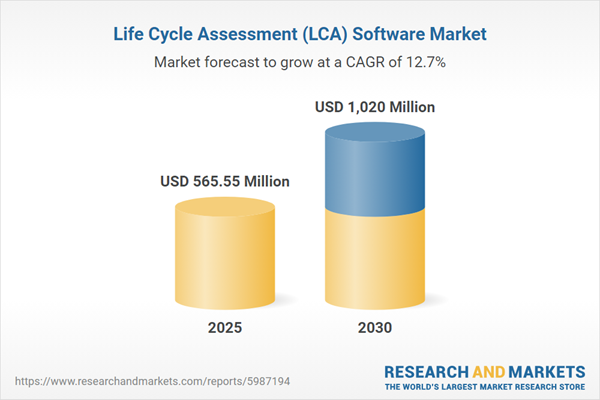The life cycle assessment (LCA) software market is projected to grow at a CAGR of 12.65% over the forecast period, increasing from US$565.551 million in 2025 to US$1.02 billion by 2030.
Life Cycle Assessment (LCA) is a process that evaluates the environmental impact of a product throughout its entire life cycle. This software solution helps assess the environmental effects of products and supports efficient and sustainable product design. The increasing output in the global construction sector is expected to drive demand for LCA software during the forecast period. LCA software facilitates efficient infrastructure design for buildings, helping to minimize their environmental impact and aiding in the selection of low-impact sites. The construction sector has seen substantial growth in major economies; for example, the Office of National Statistics in the UK reported a 4.2% increase in new-work construction output in 2023, reaching GBP 139.02 billion.
Life Cycle Assessment (LCA) is a process that evaluates the environmental impact of a product throughout its entire life cycle. This software solution helps assess the environmental effects of products and supports efficient and sustainable product design. The increasing output in the global construction sector is expected to drive demand for LCA software during the forecast period. LCA software facilitates efficient infrastructure design for buildings, helping to minimize their environmental impact and aiding in the selection of low-impact sites. The construction sector has seen substantial growth in major economies; for example, the Office of National Statistics in the UK reported a 4.2% increase in new-work construction output in 2023, reaching GBP 139.02 billion.
Drivers of the Life Cycle Assessment Software Market:
- Growing Demand for Food and Beverage Products: The rising global demand for food and beverage products is a key factor propelling the growth of the LCA software market. In this sector, LCA software ensures a more sustainable and environmentally friendly procurement process for raw materials while helping to minimize production waste.
- Increasing Production in the Construction Sector: The expanding construction sector, particularly in developing countries, is expected to further boost demand for LCA software during the forecast period.
- Rising Demand for Packaged Foods and Beverages: The growing global appetite for packaged food and beverages is driving the need for effective LCA solutions to assess and improve sustainability practices within this industry.
Geographical Outlook of the Life Cycle Assessment Software Market:
- Significant Growth in North America: North America is expected to hold a substantial share of the LCA software market. The United States is experiencing growth in industrial production and is investing heavily in technological innovations while applying industrial standards that optimize energy distribution. Growing concerns about carbon emissions have accelerated the transition toward sustainable practices, prompting efforts to enhance adoption levels in commercial and industrial operations.
Reasons for buying this report:
- Insightful Analysis: Gain detailed market insights covering major as well as emerging geographical regions, focusing on customer segments, government policies and socio-economic factors, consumer preferences, industry verticals, other sub-segments.
- Competitive Landscape: Understand the strategic maneuvers employed by key players globally to understand possible market penetration with the correct strategy.
- Market Drivers & Future Trends: Explore the dynamic factors and pivotal market trends and how they will shape up future market developments.
- Actionable Recommendations: Utilize the insights to exercise strategic decision to uncover new business streams and revenues in a dynamic environment.
- Caters to a Wide Audience: Beneficial and cost-effective for startups, research institutions, consultants, SMEs, and large enterprises.
What do businesses use our reports for?
Industry and Market Insights, Opportunity Assessment, Product Demand Forecasting, Market Entry Strategy, Geographical Expansion, Capital Investment Decisions, Regulatory Framework & Implications, New Product Development, Competitive Intelligence.Report Coverage:
- Historical data & forecasts from 2022 to 2030
- Growth Opportunities, Challenges, Supply Chain Outlook, Regulatory Framework, Customer Behaviour, and Trend Analysis
- Competitive Positioning, Strategies, and Market Share Analysis
- Revenue Growth and Forecast Assessment of segments and regions including countries
- Company Profiling (Strategies, Products, Financial Information, and Key Developments among others)
The Lifecycle Assessment Software Market has been segmented as following:
- By Deployment
- On-premises
- Cloud
- By Enterprise Type
- Small
- Medium
- Large
- By Application
- Food and Beverages
- Consumer Goods
- Packaging
- Construction
- Others
- By Geography
- North America
- USA
- Canada
- Mexico
- South America
- Brazil
- Argentina
- Others
- Europe
- United Kingdom
- Germany
- France
- Spain
- Others
- Middle East and Africa
- Saudi Arabia
- UAE
- Others
- Asia Pacific
- China
- India
- Japan
- South Korea
- Taiwan
- Singapore
- Indonesia
- Others
- North America
Table of Contents
1. INTRODUCTION
2. RESEARCH METHODOLOGY
3. EXECUTIVE SUMMARY
4. MARKET DYNAMICS
5. LIFE CYCLE ASSESSMENT (LCA) SOFTWARE MARKET BY DEPLOYMENT
6. LIFE CYCLE ASSESSMENT (LCA) SOFTWARE MARKET BY ENTERPRISE TYPE
7. LIFE CYCLE ASSESSMENT (LCA) SOFTWARE MARKET BY APPLICATION
8. LIFE CYCLE ASSESSMENT (LCA) SOFTWARE MARKET BY GEOGRAPHY
9. COMPETITIVE ENVIRONMENT AND ANALYSIS
10. COMPANY PROFILES
Companies Mentioned
- PRé Sustainability B.V.
- iPoint-systems gmbh
- One Click LCA Ltd.
- EarthShift Global
- GreenDelta
- Circular Ecology
- Athena Sustainable Materials Institute
- Solid Forest
- Sphera
- Altermaker
- Minviro Ltd
- P6 Technologies
- SCS Global Sevices
- Intertek Group plc
- SolidWorks Sustainability
Methodology

LOADING...
Table Information
| Report Attribute | Details |
|---|---|
| No. of Pages | 141 |
| Published | January 2025 |
| Forecast Period | 2025 - 2030 |
| Estimated Market Value ( USD | $ 565.55 Million |
| Forecasted Market Value ( USD | $ 1020 Million |
| Compound Annual Growth Rate | 12.6% |
| Regions Covered | Global |
| No. of Companies Mentioned | 15 |









